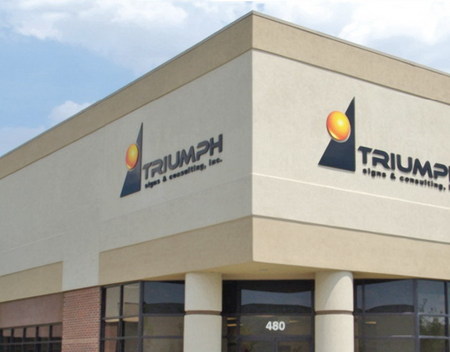Business Management
Customer Service and Salesforce
Triumph Signs and North American Signs provide insights into capitalizing on customer service and handling sales.
Published
17 years agoon

Face it: As a small-business owner, you can’t compete with the Wal-Marts of the world on price or variety. You can, however, blow their doors off by capitalizing on your greatest asset, customer service.
Customer service can’t be stressed enough. In fact, it’s a flat-out necessity in today’s business environment. A recent National Federation of Independent Business study found that small businesses that emphasize customer service are more likely to succeed than competitors who stress lower prices. “It’s what gives you the edge,” wrote Rieva Leonsky, senior vice president and editorial director of Entrepreneur.com. “A lot of people will pay a few more dollars to know they’re being well served.”
A customer-service emphasis, and economic investment in it, varies drastically from industry to industry, company to company. Balancing costs and benefits should determine spending on customer service. Companies need to determine: Does resulting revenue exceed incremental costs to increase profit margins?
In 2003, a Harvard Business School study examined Starbucks Corp.’s efforts to balance the cost of improving customer service with the expected increased revenue. A year earlier, the coffee chain had to decide whether to spend $40 million nationwide to add 20 hours of labor per week to each store to speed up service. That $40 million shaved seven cents a share off earnings. But, according to the Harvard study, Starbucks learned service influenced its coffee drinkers. Its highly satisfied customers spent 9% more than those who were simply satisfied.
Triumph Signs and Consulting Inc., a Cincinnati-based, full-service electrical sign company, also examined the cost-versus-benefit, customer-service equation and opted for unparalleled customer service, the company reports. Improvement came with technology, and it came at a cost.
AdvertisementIn 2005, Triumph’s inception, co-owners Bill Downey and Tony Jennings attended tradeshow after tradeshow, scrambling to find a software-design firm that could create a customized, customer-based webporting program that would attract and retain customers. Most of the companies they spoke to – especially in the early brainstorming stages – offered only generic, work-order templates, for approximately $30,000. But what would it cost, they wondered, to design a customizable software program, one that fits their needs? Approximately a quarter of a million dollars. The two men examined the cost-benefit equation, but after further consideration and two years of implementation, it was justified.
Here’s how their system works. Each client is given a username and a password to log in at the company’s website. Once inside, the client can track an installation’s progress, with detailed step-by-step procedures, including photos taken by the service technician; view an entire work-order history; and research various surveys.
“This is especially attractive to our national clients, who are constantly in the air traveling,” said Jennings. “They can check into their hotel room, open the laptop and check the status of a project. It’s really that easy.”
Companies often mistakenly believe they can substitute technology for employee hiring and training, customer-service experts say. “The people side of the experience is the most important to take care of,” said Tom Knighton, a partner at Mercer Delta Consulting, a Chicago-based consulting firm. “The payoff comes in places where customers are interacting with people.”
This doesn’t eliminate technology from the cost-benefit equation. For instance, Triumph Signs attempts to blend technology-based tools with personal service. Say there’s been a malfunction with a sign computer board. The customer, 400 miles away in Chicago, phones and speaks to the assigned project manager. The project manager, if possible, walks the customer through the troubleshooting areas. If trouble still persists, Chicago is only a five-hour drive, said Jennings.
Salesforce
AdvertisementWhen starting up your signshop business, you may be the lone sales manager, marketing director and salesperson – all in one. But what do you know about business management? After all, you hold a BFA in design, not an MBA.
Comedian Mitch Hedberg once described Hollywood’s obsession with comedians like this: “When you’re in Hollywood, and you’re a comedian, everyone wants you to do other things. So, you’re a stand-up comedian. Can you write us a script?’ Mitch says to the crowd, playing the role of a Hollywood producer. “That’s not fair,” he says, playing the role of himself. “That’s like if I worked really hard to become a good cook, and they’d say, ‘Okay, you’re a good cook, but can you farm?’”
For small-shop owners starting out, the answer is always “yes.” Yes, I can design. Yes, I can sell, and yes, I can market the business. If these business facets are handled well, the business will inevitably grow.
As the company grows, additional people will need to be added to handle specialized jobs. And, perhaps someday, this will include a chief financial officer and vice president of operations. But, before the massive, corporate leap, the first specialized area needs to be sales.
It’s no mystery. Sales drive growth. In a perfect business model – all things being equal – the more salespeople you have, the more sales the company generates. Thus, adding the right salespeople and improving on your existing sales team can grow the business.
Hiring the wrong salespeople, though, can hurt sales, damage valuable customer relationships, erode profits and destroy the company’s image.
AdvertisementA recent article, which appeared on Entrepreneur. com, states there may not be any bad salespeople, but rather just good salespeople in the wrong positions.
There are two sales camps: key-account management and new-business development. Key-account salespeople maintain a rapport with longterm clients, while new-business development entails identifying prospective and qualifying leads.
John Yarger, president of South Bend, IN-based North American Signs Inc., says knowing your salespeople’s strengths are essential for growth and, more importantly, success. “It’s a special breed of salespeople who excel in both areas,” he says, “and it’s important to balance the talent against the challenge.”
Think in terms of coaching football. Would you send your 350-lb. nose guard back to return punts? Of course not; you signed him to a million-dollar deal because he stops the run, not because of his hands or speed.
Yarger oversees six salespeople. The challenge, he says, is ensuring they have proper training and sufficient resources to provide new-account development and key-account management.
For Yarger, salespeople are the company’s front-line troops, the ones with the most customer contact. So, it’s vitally important they’re trained properly, he says; great emphasis is placed on both independent, off-site events and regularly held sales meetings.
North American Signs, founded in 1934 under the name “South Bend Neon,” originally fabricated neon signs, locally. The company has broadened its scope to such national accounts as Fidelity, OfficeMax, Gamestop and Red Roof Inn. To reflect this shift in business, the company changed its name in 1974. Today, with a team of more than 100 employees, North American Signs handles national repairs, national project management and site-enhancement services, which includes sign-zoning and permit consulting. Yarger uses a simple bathtub analogy to describe business growth. “Revenue growth in business,” he said, “is simply the water added, or new customers, minus the water going down the drain, or lost customers.” The key to our success, John said, is to serve existing customers in ways that retains them, while adding new customers to the mix. Technology, marketing and sales are simply the tools by which sign companies retain and attract customers. But, fundamentally, people grow the company.

SPONSORED VIDEO
Introducing the Sign Industry Podcast
The Sign Industry Podcast is a platform for every sign person out there — from the old-timers who bent neon and hand-lettered boats to those venturing into new technologies — we want to get their stories out for everyone to hear. Come join us and listen to stories, learn tricks or techniques, and get insights of what’s to come. We are the world’s second oldest profession. The folks who started the world’s oldest profession needed a sign.
You may like

NUtec Digital Ink Invests in Solar Energy for Facility

5 Reasons to Sell a Sign Company Plus 6 Options

21 Larry Albright Plasma Globes, Crackle Tubes and More
Subscribe

Bulletins
Get the most important news and business ideas from Signs of the Times magazine's news bulletin.
Most Popular
-

 Tip Sheet1 week ago
Tip Sheet1 week agoAlways Brand Yourself and Wear Fewer Hats — Two of April’s Sign Tips
-

 Photo Gallery3 days ago
Photo Gallery3 days ago30 Snapshots of the 2024 ISA Sign Expo
-

 Ask Signs of the Times5 days ago
Ask Signs of the Times5 days agoWhy Are Signs from Canva so Overloaded and Similar?
-

 Real Deal2 weeks ago
Real Deal2 weeks agoA Woman Sign Company Owner Confronts a Sexist Wholesaler
-

 Benchmarks1 week ago
Benchmarks1 week ago6 Sports Venue Signs Deserving a Standing Ovation
-

 Paula Fargo11 hours ago
Paula Fargo11 hours ago5 Reasons to Sell a Sign Company Plus 6 Options
-

 Photo Gallery11 hours ago
Photo Gallery11 hours ago21 Larry Albright Plasma Globes, Crackle Tubes and More
-

 Women in Signs2 weeks ago
Women in Signs2 weeks ago2024 Women in Signs: Megan Bradley











